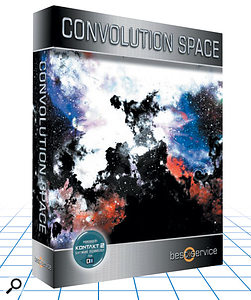Regular readers will know that I'm partial to convolution in all its aspects, and have even given seminars exploring some of its more creative possibilities. So when Best Service released Convolution Space (CS) I was keen to give it a test drive. This 8.5GB library comes on two DVDs, offers 625 instruments and, like various other libraries offering special features, uses NI's Kontakt 2 Player.
In essence, CS offers a number of uniquely playable atmospheres, each of which is created from a single sample that you can transpose and play polyphonically over the keyboard range. These are then 'convolved' with an impulse‑response sample, and the balance between the dry instrument and the wet, convolved version can be controlled in real time using the mod wheel.
CS offers separate folders containing stereo and 5.1 surround instruments, and the entire library is presented both with convolution effects alone, and with added Kontakt effects such as EQ, Delays and phasers, all neatly sorted into folders with names such as Abstract, Emotional, Fantasy, and Scary. CS also provides 'High CPU' and 'Low CPU' versions. The latter gives slightly lower audio quality when the single instrument sample is transposed away from its C3 root note, but I doubt that most users would notice the difference in the context of a project, and it certainly reduces processor overhead considerably.
The source material for both instrument and IR samples is extremely diverse, exploring synths, machinery, people, nature and city sounds, most of it post‑processed through more hardware and software to create complex textures and soundscapes. As anyone who's spent time using convolution will already know, it's tricky to predict exactly how the two signals will interact when convolved, since the results will depend on how the spectral content of each varies over time.
So, although Magnus Lindberg has worked hard marrying source and IR samples in his instruments, there's potential for plenty of other interesting combinations. You can choose your own IR for any preset using the drop‑down menus: there are 38 short ones and 55 long ones for stereo instruments, and 35 for the 5.1 surround sounds, giving loads of variety (surround instruments can still be monitored on a stereo system, but you won't benefit from the wraparound and motion effects).
Don't expect to play melodies or chords with this library, because that's not the point. The overwhelming feeling is of 'abstract' sonic landscapes, and although a few sound organic in origin and can be played as lush and uplifting pads, most have an unearthly feel that's either strangely alien or dark and disturbing — whispering machinery, rumbling drones, stellar winds and tortured souls — with the mod wheel variously introducing mutant reverbs, ringing harmonics and distant drones, which, with the longer IRs, have a lingering life of their own.
Although it bypasses many convolution wonders such as pitch‑shifted firework reverbs and drums that morph into piano chords (try Spirit Canyon Audio's IR libraries for these), Convolution Space certainly lives up to its name. Its relatively high price reflects the amount of effort that goes into creating a large library, but for those who need galaxies of slowly evolving atmospheres, it's a quick and easy‑to‑use introduction to an intriguing new world of convolution effects. Martin Walker

